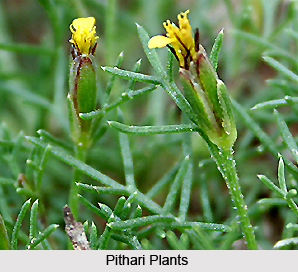 Pithari has some medicinal properties therefore the Indian practitioners of medicine consider it as an important ingredient in manufacturing the medicines. This plant is known as Glossocardia bosvallea in Botany. This Indian medicinal plant is commonly named as `Seri` in Hindi, `Parpataka` in Kannada, `Patharasuva` in Marathi and `Parapalanamu` in Telugu.
Pithari has some medicinal properties therefore the Indian practitioners of medicine consider it as an important ingredient in manufacturing the medicines. This plant is known as Glossocardia bosvallea in Botany. This Indian medicinal plant is commonly named as `Seri` in Hindi, `Parpataka` in Kannada, `Patharasuva` in Marathi and `Parapalanamu` in Telugu.
Pithari, the medicinal plant generally grows in drier regions on sandy soils. This medicinal plant is found in abundance throughout the plains of northern and western India. In southwards through peninsular India to Kerala and Tamilnadu this plant can be seen growing in hither and thither.
Pithari is an annual herb and is diffusely branched, usually prostrate and up to 25 cm long with deeply grooved stems and branches. The leaves of the plant are alternate and slender. The branches are 1.3 cm to 5 cm long and are divided into narrow segments that are linear and apiculate. The petioles vary in length and are slender. The crushed leaves have the scent of fennel. Flowers of this plant are yellow in colour and are borne in small terminal or axillary heads that are 1 cm long.
The outer involucral bracts of Pithari plant are usually three in number, ovate lanceolate, acute and are 3 mm long with membranous and slightly ciliate margins and a green midrib. The inner involucral bracts are 6-8 mm long, oblong, sub obtuse, striate and are glabrous with pale membranous margins. The pappus is composed of two stiff and slightly divaricate slender bristle like appendages. The achenes of this plant are 6 mm long, brown, narrowly oblong, flattened and are densely hairy on the edges. The plant generally bears flowers and fruits from July to September.
Pithari plant is used as an emmenagogue in medicine. In Ayurveda it is used as a substitute for Oldenlandia corymbosa. The tribal inhabitants of western Maharashtra use a decoction of the plant as febrifuge. A paste of the fresh Pithari plant is applied to promote healing of sores and wounds. It has a bitter taste and fennel like odour. Besides serving as a medicinal plant Pithari plant is also used in culinary purposes. People of some states in India take Pithari plant as a vegetable.



















